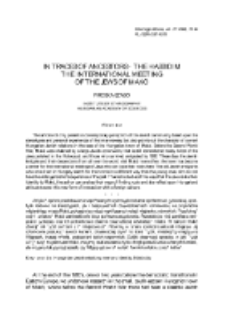- Wyszukaj w całym Repozytorium
- Piśmiennictwo i mapy
- Archeologia
- Baza Młynów
- Nauki przyrodnicze
Wyszukiwanie zaawansowane
Wyszukiwanie zaawansowane
Wyszukiwanie zaawansowane
Wyszukiwanie zaawansowane
Wyszukiwanie zaawansowane

Obiekt
Tytuł: In Traces of Ancestors - the Hassidim. The International Meeting of the Jews of Makó
Inny tytuł:
Wydawca:
Institute of Archaeology and Ethnology Polish Academy of Sciences
Miejsce wydania:
Opis:
Typ obiektu:
Abstrakt:
Artykuł, oprócz przedstawienia współczesnych wyobrażeń na temat społeczności żydowskiej, opartych zarówno na stereotypach, jak i bezpośrednich doświadczeniach rozmówców, na przykładzie węgierskiego miasta Makó, pokazuje też rodzaj współczesnych relacji węgiersko-żydowskich. Przed drugą wojną światową Makó zamieszkiwała duża społeczność żydowska. Pozostała po niej pamięć, a emigranci żydowscy oraz ich potomkowie obecnie coraz częściej odwiedzają miasto. W samym Makó zbierają się Żydzi związani z tą miejscowością. Również w Izraelu społeczność ta się integruje. Jej członkowie poszukują swoich korzeni, choć inaczej czynią to starsi Żydzi, mieszkający niegdyś na Węgrzech, inaczej młodsi, pozbawieni takich wspomnień. Dzięki obserwacji sposobu, w jaki Żydzi wiążą swoją tożsamość z Makó, możemy analizować nie tylko drogę poszukiwania własnych korzeni, ale możemy także przyjrzeć się, czy Węgrzy gotowi są na taką formę kontaktu z obcą kulturą
Bibliografia:
Dobos Ilona 1990, A csodarabbi alakja a néphagyományban. (The figure of the rabbi of miraculous powers in folk tradition), [in:] ed. K. Ildikó, A hagyomány kotelékében (In the bonds of tradition), Budapest, pp. 31—37
Erdei Ferenc 1982, Makó társadalomrajza (An outline of the society of Makó), Makó
Gerö László 1989, Magyarországi zsinagógák (Synagogues in Hungary), Budapest
Gleszer Norbert 2006, Súlajm áléchem Rabéni voMoréni... Zarándoklatok a magyarországi cádik-síroknál (Pilgrimages at the tzaddikgraves in Hungary), http://www.mzsh.hu/gtanulm.doc.
Goldberg-Mulkiewicz Olga 1995, Świat, który przestał istnieć. Refleksje nad badaniem kultury Żydów polskich (A world that is no more. The reflections on the research of Polish Jewish culture), Lud, Vol. 78, pp. 331—340
Goldberger Izidor 1908, Zsidó bucsú Ujhelyen (Jewish feast in Ujhely), IMIT Evkönyv, pp. 251—256
Hanák Peter 1985, A másokról alkotott kép. Polgárosodás és etnikai eloítéletek a magyar társada-lomban /a 19. század második felében/ (Rise of the middle class and ethnic prejudices in Hungarian society/in the second half of the 19th century/), Századok, Vol. 119, No. 5—6, pp. 1079—1104
Hertz Aleksander 1988, Żydzi w kulturze polskiej (Jews in Polish culture), Warszawa
Hunyady György 1996, Sztereotípiák a változó kozgondolkodásban (Stereotypes in a changing public mentality), Budapest
Liszka József 1997, „Da waren wir alle gleich..." /A Pozsony környekerol kitelepített németek magyarság-képe/ (The Hungarian-image of Germans deported from the area around Bratislava), Ethnographia, Vol. 108, No. 1—2, pp. 69—85
Tóth Ferenc 1998, A makói hagyma (The onion of Makó), Makó
Zsidók a mai Magyarországon (Jews in contemporary Hungary) 2002, ed. A. Kovács, Budapest
Zsigmond Gábor 1992, Makó zsidósága a két világháború között (Jews in Makó between the two World Wars), manuscript, Kézirat
Czasopismo/Seria/cykl:
Tom:
Strona pocz.:
Strona końc.:
Szczegółowy typ zasobu:
Format:
Identyfikator zasobu:
oai:rcin.org.pl:61491 ; 0137-4079
Źródło:
IAiE PAN, sygn. P 366 ; IAiE PAN, sygn. P 367 ; IAiE PAN, sygn. P 368 ; kliknij tutaj, żeby przejść
Język:
Prawa:
Prawa zastrzeżone - dostęp ograniczony
Zasady wykorzystania:
Digitalizacja:
Instytut Archeologii i Etnologii Polskiej Akademii Nauk
Lokalizacja oryginału:
Biblioteka Instytutu Archeologii i Etnologii PAN
Dostęp:
Kolekcje, do których przypisany jest obiekt:
- Repozytorium Cyfrowe Instytutów Naukowych > Kolekcje Partnerów > Instytut Archeologii i Etnologii PAN > Publikacje Pracowników i Wydawnictwa IAE PAN
- Repozytorium Cyfrowe Instytutów Naukowych > Kolekcje Partnerów > Instytut Archeologii i Etnologii PAN > Publikacje Pracowników i Wydawnictwa IAE PAN > Czasopisma bieżące
- Repozytorium Cyfrowe Instytutów Naukowych > Piśmiennictwo > Czasopisma/Artykuły
- Repozytorium Cyfrowe Instytutów Naukowych > Kolekcje Partnerów > Instytut Archeologii i Etnologii PAN > Publikacje Pracowników i Wydawnictwa IAE PAN > Czasopisma bieżące > Ethnologia Polona
Data ostatniej modyfikacji:
2 lut 2022
Data dodania obiektu:
12 sty 2017
Liczba pobrań / odtworzeń:
20
Wszystkie dostępne wersje tego obiektu:
https://rcin.org.pl./publication/77285
Wyświetl opis w formacie RDF:
Wyświetl opis w formacie RDFa:
Wyświetl opis w formacie OAI-PMH:
| Nazwa wydania | Data |
|---|---|
| Szabó, Piroska, 2006, In Traces of Ancestors - the Hassidim. The International Meeting of the Jews of Makó | 2 lut 2022 |
Obiekty Podobne
Faragó, Borbála
Kolarzowa, Romana
Minta-Tworzowska, Danuta

 INSTYTUT ARCHEOLOGII I ETNOLOGII POLSKIEJ AKADEMII NAUK
INSTYTUT ARCHEOLOGII I ETNOLOGII POLSKIEJ AKADEMII NAUK
 INSTYTUT BADAŃ LITERACKICH POLSKIEJ AKADEMII NAUK
INSTYTUT BADAŃ LITERACKICH POLSKIEJ AKADEMII NAUK
 INSTYTUT BADAWCZY LEŚNICTWA
INSTYTUT BADAWCZY LEŚNICTWA
 INSTYTUT BIOLOGII DOŚWIADCZALNEJ IM. MARCELEGO NENCKIEGO POLSKIEJ AKADEMII NAUK
INSTYTUT BIOLOGII DOŚWIADCZALNEJ IM. MARCELEGO NENCKIEGO POLSKIEJ AKADEMII NAUK
 INSTYTUT BIOLOGII SSAKÓW POLSKIEJ AKADEMII NAUK
INSTYTUT BIOLOGII SSAKÓW POLSKIEJ AKADEMII NAUK
 INSTYTUT CHEMII FIZYCZNEJ PAN
INSTYTUT CHEMII FIZYCZNEJ PAN
 INSTYTUT CHEMII ORGANICZNEJ PAN
INSTYTUT CHEMII ORGANICZNEJ PAN
 INSTYTUT FILOZOFII I SOCJOLOGII PAN
INSTYTUT FILOZOFII I SOCJOLOGII PAN
 INSTYTUT GEOGRAFII I PRZESTRZENNEGO ZAGOSPODAROWANIA PAN
INSTYTUT GEOGRAFII I PRZESTRZENNEGO ZAGOSPODAROWANIA PAN
 INSTYTUT HISTORII im. TADEUSZA MANTEUFFLA POLSKIEJ AKADEMII NAUK
INSTYTUT HISTORII im. TADEUSZA MANTEUFFLA POLSKIEJ AKADEMII NAUK
 INSTYTUT JĘZYKA POLSKIEGO POLSKIEJ AKADEMII NAUK
INSTYTUT JĘZYKA POLSKIEGO POLSKIEJ AKADEMII NAUK
 INSTYTUT MATEMATYCZNY PAN
INSTYTUT MATEMATYCZNY PAN
 INSTYTUT MEDYCYNY DOŚWIADCZALNEJ I KLINICZNEJ IM.MIROSŁAWA MOSSAKOWSKIEGO POLSKIEJ AKADEMII NAUK
INSTYTUT MEDYCYNY DOŚWIADCZALNEJ I KLINICZNEJ IM.MIROSŁAWA MOSSAKOWSKIEGO POLSKIEJ AKADEMII NAUK
 INSTYTUT PODSTAWOWYCH PROBLEMÓW TECHNIKI PAN
INSTYTUT PODSTAWOWYCH PROBLEMÓW TECHNIKI PAN
 INSTYTUT SLAWISTYKI PAN
INSTYTUT SLAWISTYKI PAN
 SIEĆ BADAWCZA ŁUKASIEWICZ - INSTYTUT TECHNOLOGII MATERIAŁÓW ELEKTRONICZNYCH
SIEĆ BADAWCZA ŁUKASIEWICZ - INSTYTUT TECHNOLOGII MATERIAŁÓW ELEKTRONICZNYCH
 MUZEUM I INSTYTUT ZOOLOGII POLSKIEJ AKADEMII NAUK
MUZEUM I INSTYTUT ZOOLOGII POLSKIEJ AKADEMII NAUK
 INSTYTUT BADAŃ SYSTEMOWYCH PAN
INSTYTUT BADAŃ SYSTEMOWYCH PAN
 INSTYTUT BOTANIKI IM. WŁADYSŁAWA SZAFERA POLSKIEJ AKADEMII NAUK
INSTYTUT BOTANIKI IM. WŁADYSŁAWA SZAFERA POLSKIEJ AKADEMII NAUK




































